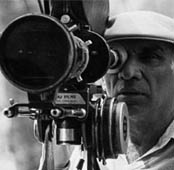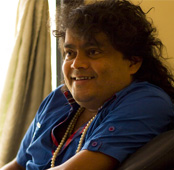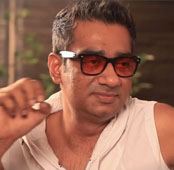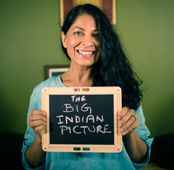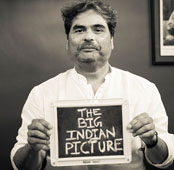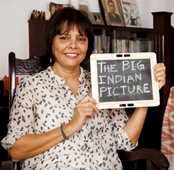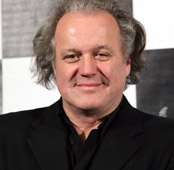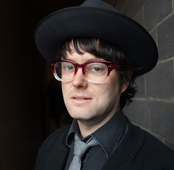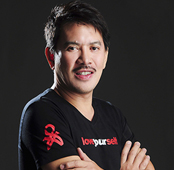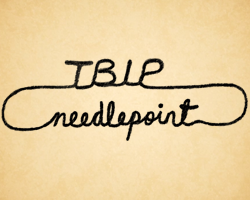
On Needlepoint is a series on Fashion and Films, because ever since they were introduced to each other by Glamour, they’ve maintained a deep and exciting friendship, collaborated fruitfully, gotten up to mischief and given us more than a couple of exquisitely dazzling moments in history.
Philip Treacy, 46, is the man who single-handedly changed the meaning and destiny of the hat.
Graduating from the Royal College of Art, in London, in 1990, Treacy set up a workshop in the basement of the late, iconic Tatler Style Editor (later Fashion Director) Isabella Blow’s London home. From there he went on to design hats in collaboration with some of the world’s best designers, such as Karl Lagerfeld, Valentino, Ralph Lauren and Donna Karan. Treacy has won the title of British Accessory Designer of the Year, at the British Fashion Awards, five times, and been awarded an honorary OBE—an order of chivalry that stands for ‘Officer of the Most Excellent Order of the British Empire’—for his services to the British fashion industry, by Prince Charles.
He has designed hats for some of the best known movies, such as the Harry Potter films. Also, Sarah Jessica Parker’s hat for the première of Sex and the City. 36 of his hats were worn at Prince William and Catherine Middleton’s wedding— including the military pillbox hat worn by Victoria Beckham and the now infamous ‘fascinator’ donned by Princess Beatrice of York.
But Philip Treacy’s hats transcend conventional notions of propriety. Whether it is the stunning telephone-shaped headpiece, with a removable handset, that Lady Gaga wore on Friday Night with Jonathan Ross, or simply a ‘B-l-o-w’ sculpted out of feathers on Isabella’s head, they are always more than ‘headgear’. They are news. They are characters. They tell the most fantastic stories.
In this interview the world’s greatest milliner talks about his adventures with art, design, fashion, pop-culture and Hollywood. He tells us stories that involve the likes of Grace Jones, Michael Jackson, Baz Luhrmann, Alexander McQueen and Elizabeth Taylor— his subtlety and humility belying his incredibly extravagant and witty designs.
An edited transcript:
Okay, I’m going to start with a very basic question. You have single-handedly changed the meaning, the perception, the destiny of the hat. Tell me what drew you to hats in the beginning? Did your fascination for them predate your time at the National College of Art and Design?
It didn’t, really. I kind of just started then. You know, I studied fashion design, and I liked to, sort of, try to make a hat as well, and I made one hat one time from an old vintage hat. But the straw was very good— and so I said to my teacher that I’ve made a hat. And she said she’d like to see it, so when I showed it to her she bought it. So I thought: Okay, that’s a result. So it’s just something… the physicality of making something from nothing. Which is the essence of what hat design is really about, because you’re starting, you’re working with a two dimensional material and you’re turning it into three dimensions. The physicality of doing that is what’s interesting.
Yes. You know, which brings me to the fact that—both in the way that you make your hats and in the way they shape up—it’s also a form of artistic sculpture. So I really wanted to know about the influence of (Salvador) Dali and the surrealists on your work, because that’s always intrigued me. And any other artists of course that might have inspired you.
I mean, surrealism is interesting. I haven’t been particularly influenced by Dali. But there are some ‘Dali-esque’ things like, you know…
The lobster hat…
Lobsters or Lady Gaga or Isabella Blow, but I really just like to sort of start with a blank page and a pencil and see what comes up. So I don’t really reference lots of different things, it’s always really about kind of the personality of the person, or the imagined person.
Yeah. Okay, so that’s interesting. So you’re saying that it’s not intentional quotation-ism, it’s not intentional referencing; it’s all the various influences that you like flowing into…
Yes, because that’s how it really works. Because you will go to… you will see… You know, we live in a visual world. So subconsciously it can come out later, but I don’t really do things like go to museums to do research because I prefer to take it from inside my head.
Sure, but was it a period of art that you like for itself?
You mean surrealism?
Yes, the surrealists.
Well you know, surrealism and hats have been a very important genre because of (Elsa) Schiaparelli or… it’s just… it’s entertaining. Which is what a hat is also. It’s entertaining.
Outside of your design, what kind of art do you…
I love Andy Warhol and Leonardo da Vinci and… lots, I mean lots but not… I like very beautiful things. And there’s something unbelievable about Leonardo da Vinci’s paintings or drawings. So it’s not all about Damien Hirst— I like what he does, but, you know, art has been going on for thousands of years, so it’s not all about modern art, but I do like… I love photographs. So I collect Clarence Sinclair Bull images from the twenties, because he was the MGM (Metro-Goldwyn-Mayer) photographer. And one time when I was in Los Angeles I came across these incredible photographs in a junk shop. They didn’t know who it was and I was like— I’m sure that’s Greta Garbo and then I checked it out and so… I collect photographs. But I’m lucky to be able to collect photographs of my hats by the best photographers in the world, from Irving Penn to Bruce Weber, to… it’s all about a photograph, it’s… hats come about, you know, they’re evocative of another time.
Yeah, and they get a second life in photographs.
Well, kind of. Movies and photographs are probably my biggest influence, because they are… You know, Hollywood, early Hollywood, invented contemporary glamour.
Yeah I was actually going to come to that. But before that, just a small question. When worn, your hats are also akin to performance art, you know. So they combine with the wearer to become a sort of performance art. If you were to pick one of these two terms for your work, which one would you pick— theatrical or cinematic?
Cinematic.
Cinematic. Why would you pick cinematic?
Because theatrical is… it has kind of put-down connotations. Whereas I think about them in a cinematic way, and I develop them in a cinematic way, and when I’m making or developing the whole thing I can see what’s happening clearly— so I know where the beginning and the end is. I know when it’s finished. So I’m drawing with materials.
That’s very interesting to me because I remember reading an interview of yours where you spoke about a client of yours who said to you that you don’t merely sell hats, you sell dreams. And that made me think of how filmmakers are actually usually called dream merchants, and I was going to ask you about your cinematic inspirations. Filmmakers, or films, that really get you going. They may not translate literally into the work you’re doing…
Yes. I think kind of early Hollywood films are the most interesting for hats because at that moment directors knew how to light a hat. And so it wasn’t just blasting white light, it was dramatic. So shadows, or illusion, or allure, or what it was suggesting, whereas today directors aren’t used to them, and don’t light them properly. Because they don’t get it. So they don’t understand that it’s interesting not to reveal everything, which is what a hat can do. But most directors are afraid of hats now.
Are they? Why would you say that?
Well, they just don’t know how to light them. Whereas the early Hollywood movies, they allowed them to… in black and white there were just more contrasts.
That too, yeah. Maybe it’s also the way they look at hats. I mean maybe hats need to be looked at slightly differently from the way you look at clothes maybe, because you have to see it as an extension, as a part of the face.
It’s armour for the face. You know, many people think that people that wear hats are trying to show off. But actually it’s a protection. And people always presume that people that wear hats are extroverts and want everybody to look at them. When in fact—because I make hats for lots of those people—I understand that they gain their power from a hat. So they feel… when you’re wearing something beautiful then you feel good.
Yeah, I know what you mean.
So hats are actually empowering for women. And it’s about how it makes you feel. You know, designers have no power today to dictate what fashion is. Because at one time you know, designers would have the colour of the season or the cut of the season or the look of the season. And now it doesn’t really exist. There are, sort of, trends that exist for magazines. But people… the power today is with the consumer. And so people are more confident in themselves. So you cannot say that one particular thing is the most fashionable at the moment, because it’s a world of choice.
Yeah and fashion is no longer prescriptive. That’s very interesting. But you know, you designed for the Harry Potter films.
Yes.
And I wanted to know what fresh excitement and challenges costume designing for films brought to your life.
Well, it’s a moving picture. So it’s interesting the detail that— the amount of detail that goes into movies. I’ve been lucky enough to go on Tim Burton’s sets for Sleepy Hollow, and another one, and it’s amazing. And then last year when I was in Australia… What’s the man who did Moulin Rouge?
Baz Luhrmann.
Baz Luhrmann. So he invited us to visit the set for The Great Gatsby and he showed us some footage and, it’s incredible…
That must have been incredible.
It’s just delicious. Feast for the eyes.
Those are both directors that I wish you’d work with. I wish they worked with you.
Well, they have big personality, and they bring personality to their movies.
And they’re both so different.
And they’re both so different.
I think they’d both be a good fit with…
Yes, I’d love to. But fashion doesn’t cross over that much into film. But I’m interested to change that.
Also because what you do is not merely fashion. But would you like to do more of costume design? Can you think of a film already made that you wish you’d designed?
Yes, I think some of my biggest cinematic influences are (Federico) Fellini, and I love his movies and when I saw Juliet of the Spirits, I didn’t understand it, but I just thought there were just all these mad women trekking around in the wildest looking hats, so, you know… and (Fellini’s) Casanova— the movie’s extraordinary. I mean I love the fact that he spent the whole budget in the first two minutes of the movie, sinking a ship. And, you know, I believe in all those kind of people that are ‘extra’. Because they… it has to be like that.
Is he one of the people you would have liked to meet, if he…?
Yes. He had an amazing sense of costume or, you know, really unhinged looking people in his movies.
Yeah. You know, this is something you touched upon earlier. I remember you saying somewhere that what brings a hat to life is the personality of the wearer.
Hm.
Now I was wondering— you have the most diverse list of iconic clientele. How do you synergize your creations with personalities as diverse as a Kate Middleton and Dita Von Teese and Sarah Jessica Parker maybe in the middle somewhere? And what do the personalities bring to your inspiration? I mean we began talking about that earlier, when you said that it grows from the person you’re making it for.
Yes, well it’s interesting to make hats for… some people are more interesting than others. And people who wear hats have that little bit extra. I mean, you know, Lady Gaga’s not boring, or Sarah Jessica Parker. They’re kind of larger than life people.
But yet, in very different ways.
Completely different ways. And it’s just that, you know, what you would make for one, you think about the person. You think about their personality, where they’re going, what they’re wearing it to. And also, you know, these people are entertainers, and I’m entertaining on their heads. So it’s more fun to make a hat for Sarah Jessica Parker going to the Sex and the City première than it is to make a hat maybe for Sharon Stone going to a première of her movie. It doesn’t really work. It’s just that Sarah Jessica Parker embodies that… you know, the character she plays loves fashion. So it was fun to do that for her.
So would you say it’s more instinctive, that you know these people and then you sit down with a pen and paper and then it’s just…
It’s a little bit like visiting a psychiatrist when you come and have a hat made. Because I am trying to understand: A) What you don’t, do not, want and B) How to help you to… um… how to make you happy with that hat. But I don’t… it’s just… just from talking to somebody I can learn. So it’s not an interrogation…
You mentioned Lady Gaga, and how your work is such an integral part of her expression. As it was once with Isabella Blow’s persona.
You know, she’s a kind of twenty first century pop version of Isabella. She’s a commercial version of Isabella.
I was going to ask you if you see any similarities in the way that both these women use design for self expression. Or any differences.
Yes, well, what’s interesting about Lady Gaga is that she’s not… A) She’s very talented and very young, but B) She’s not trying to be the beautiful girl, like other pop star girls are. They’re just trying to be beautiful whereas she has a different version of that.
She’s not trying to be pretty.
Yes, she’s not trying to be Cindy Crawford. Because she’s not. But she is on the edge. And what’s interesting is that it’s a commercial phenomenon because people… they like it. They like her. There’s something attractive about her.
Yeah, and very intriguing.
And very intriguing.
She’s brought mystery back onto the pop culture sphere.
Yes. Well there are a lot of… kind of… pop people, you know…
But you know, mystery had gone out of that arena entirely. The aura, the mystery, which is such an integral part of even early Hollywood that you mentioned— there was an air of mystery.
Yeah well, it’s also boring, all those people, because they all look the same, and they’re all wearing the same dress, and they’re all wearing the same hair, and it is supposed to be entertainment. They are entertainers and we’re looking to be entertained. So some people entertain better. But what she has in particular is that she can sing. You know, pop stars that can sing are a revelation these days, because many can’t.
You know you’ve collaborated with some of the most exciting design houses in the world, be it Chanel or Armani or Alexander McQueen of course.
Yes.
I was wondering, given how individualistic and distinct your own sense of style is, how these collaborations worked for you?
I kind of get into their zone when I work for them. So, they expect a lot. So they don’t just want any old hat. It has to be something that’s never been seen before, that’s totally revolutionary, and that’s original. And originality is a currency that I have to work with, because they expect that.
So you’re saying it also becomes a challenge that you enjoy, that you need.
The challenge is frightening and exciting, because that’s the… it’s supposed to look easy. It’s supposed to be effortless but in fact it’s not. And that’s why there have been so many kinds of fashion casualties, because it’s very stressful. I have a different thing, but they have ten collections a year every two months— something like that. There’s just too much, and too many clothes, and too many… you know, it’s been taken over by corporate-ness. It’s not about creativity, it’s about corporate… Well, those big, kind of corporate cannibal brands.
Well, you’ve seen that change come in.
Yes, yes. I mean everybody’s a designer today. Everybody is an artist. And everyone is an expert. And I think that’s good in one way but in another way it just means that there’s a lot of things, a lot of clothes, and you don’t know whether it’s kind of… cheap can be expensive and the expensive can look cheap. So it’s all… it’s just a lot.
I’m sure there are plenty of examples, but can you think of any one particular collaboration that you really, really enjoyed with a designer?
I kind of enjoy every collaboration because you have to, otherwise you don’t… I mean some are more stressful. It’s very easy to work with a very strong designer. It’s very difficult to work with a mediocre designer because they don’t know what they want and you don’t know what they want. Whereas I’ve been lucky to work with the kings of fashion, because I can get into what they want. I can deliver it. It’s exciting to work with all of them. You know, working with Ralph Lauren was really exciting because he’s just completely the opposite of what I’m about. So when they asked me I thought he was joking. I was like: Me? And Ralph Lauren? So I went to see him and I took him, at first, some kind of quite conservative looking hats. It was like the X factor, and he was not getting it. And then I said okay, let’s show you something else, completely different. And he wanted something modern. But probably my most interesting collaborations have been with Alexander McQueen.
Yes, what a match-up.
So he had something completely exceptional because you didn’t really feel the commerce when you worked with him. Because it was always excellent, always completely different to last time and always original. And the energy around his shows, which were performances. Because you know, when you show, it’s a performance, and models are performers. Models are the unsung heroes of fashion because it looks easy, well everyone thinks it’s easy, but in fact it’s actually quite difficult to project that.
And would you say Alexander was also one of the most demanding out of the designers you’ve worked with?
Yes. Because there just wasn’t an option to… I mean, I just couldn’t pitch up without something incredible. He’d really try you out, without meaning to, but his passion for it was… I just couldn’t disappoint him. So sometimes he’d want a bird made out of wood, or he’d want the maddest things. The strength of the hats and the strength of the clothes— it worked. Because he was a very strong clothing designer, and my hats are very strong, and he wasn’t afraid of them. So put together with the girls and the make-up and hair, it worked. Whereas on some other designers it just wouldn’t be right. It’s fun to work with people that are fearless.
Yes, because that brings that quality to your life for that period as well, I imagine.
And also, you know, everybody always says, “Who’s your favourite person,” or “Who do you like better.” You can’t say. Karl Lagerfeld, he’s a trip. And Valentino… they’re all different, completely different, people. And they’re extraordinary.
Are you planning to write a book someday?
Um… No.
I hope you do.
But I’ve got a lot of interesting experiences with all of them at a very young age, so I was intimidated by all of them for many years. And as you get older you are less intimidated.
Your return to London Fashion Week this year was hugely successful, but also the hat doff—if you pardon the pun—to Michael Jackson. Now two questions here. Did you ever design for him?
No. Well, actually, I have a hat that looks like a ship, a sailing ship, and he tried to buy it twenty years ago when it was in this window in Bergdorf’s (Bergdorf Goodman) in New York, and he offered twenty five thousand dollars for it. But I only had one ship. And even though I loved the idea of it going off to Neverland (Neverland Valley Ranch, Jackson’s home) I didn’t. So I loved that he wanted it. But he was an exceptional entertainer. He was the greatest entertainer of the twentieth century, really.
Easily.
Well, he was also a visual entertainer, so he had tricks that he was very clever with. Like his glove, or the style of his clothes. You know we had all his clothes in my studio for about a month before the show. And the energy that emanated from them when you’d walk into the room was interesting. His trousers, those black trousers with the white stripe that he’d perform Billie Jean in. It was amazing to see those things. They’re like pop relics.
He really worked the medium. He knew the medium and worked it, he was incredible. But can you think of any other instances where you’ve used your work in this way to reinvent something from…
Grace Jones
Oh yeah.
I worked with her for many years. And she was one of the first entertainers I worked with. We’ve known each other 15 years, and I art-directed some of her concerts for her, and would do her shows with her… She’s a delicious nightmare, but she’s also a wonderful person. But an extraordinary entertainer. She is exciting to work with. I went to New York a couple of months ago to do her show at the Roseland (Ballroom) in Times Square. And Grace is an unpredictable character, and she’s fearless, so she isn’t afraid to take chances. Because that’s what’s interesting about all these people, they’re… Yes, they take chances. And some people don’t. But I’ve always ended up working with and being attracted to the ones that are on the edge.
Yeah, well I’m sure it’s rewarding to do that.
It is. It’s interesting.
You touched upon this earlier, you said you love early Hollywood cinema and you said you love Fellini. What else do you personally like watching, when you go home what would you pop into a DVD player? What would you like to watch?
Um, I don’t really care. Any kind of rubbish, really. It’s entertainment. But I like beautiful movies, like (Luchino) Visconti, or unusual movies, documentaries… I particularly like… have you ever seen that film Ludwig?
Yeah.
So, that’s incredible. I mean we’ve learned so much from movies like this. They transport you into another world, really.
Have you seen any Indian cinema at all?
I’ve seen a few, yes. But I haven’t seen a lot. But I like that sense of exuberance, because it’s transportive. It’s not… it’s pure entertainment.
Can you recall anything you’ve seen which might have been from India?
Numerous kinds of Bollywood movies on TV or whatever. But I like the simplicity of the approach. It has got a different kind of approach to every other culture’s cinemas, because it’s enthusiastic, and it’s uplifting.
Yes, and it’s extremely enduring. It’s the one thing that connects all of India. You know, it’s lasted in its original form forever, which is incredible.
Well it kind of links very well with those early Hollywood films we were discussing, because they were to entertain and to uplift, in times when there was much economic strife. So a movie has the power to do that. Because we all want to be somebody else at different points in the day or week.
Yeah, I think Bollywood’s never quite taken its focus off that one primary goal of upliftment and just, you know, pure entertainment.
And exuberance.
And exuberance. Yeah, you’re right about that.
And so it has more connection with Baz Luhrmann than it would with something else. Because his is a kind of Bollywood approach as well, because it’s extra. You know when we went to see the set of The Great Gatsby, and they were filming that day, on the way when we were going there, I thought: Why is Baz Luhrmann making The Great Gatsby? And then when he showed us the footage, I thought it’s his version of The Great Gatsby. So it’s just incredible. The most incredible things happen in the movie. And it’s a feast.
It’s a feast.
Yes. And visual feasts are probably my favourite parts of movies.
Yeah, that would be a great way to describe it. I read somewhere that you gave away twenty five hats to Elizabeth Taylor once. Clearly, you must have been charmed.
Well she’s a mythological movie star. And she’s just always been there. And she was there before Madonna, J.Lo (Jennifer Lopez), all those people. She invented celebrity extravagance. And she was completely spoilt from when she was a very young girl. And she liked a lot. And she loved extra. More diamonds, clothes. So I was on a shoot one day, and I got a phone call to say, you know, Elizabeth Taylor’s assistant is on the telephone, and she wondered if you would make Elizabeth Taylor a hat pin. In twenty years no one’s ever asked me for a hat pin. So I thought, okay. So I got back—somebody got back to her—and I said ask her does she want a hat to go with the hat pin? And she did. We went to see her in The Dorchester (London) and she was extraordinary, because I was expecting a very, very difficult person, which I’m sure she was capable of being. But she was really charming and she talked a lot about her movies and about Cleopatra, and she showed me all her diamonds. And she ordered a cocktail waiter to come up to the room and make us cocktails. So it was like more than I’d even expected. And then we did a show for her, on her, with the bathroom mirror, and she was entertaining and wonderful and loved it all and kept asking me, over and over again, which hat she can have. So I thought it’s too boring to tell Elizabeth Taylor which hat she can have. Because it was exciting. She was the ultimate… she was the ultimate celebrity. And so I gave her all the hats. I just thought it’s too tacky saying you can have this one. Because it was inspiring, for me to meet her.
Yeah.
And she was warm and friendly, and funny, and talked about her costumes and how she would know this character, or would know the scene, from looking at the costume. So, you know, costumes are very important to movies.
Yeah, well at least they used to be.
Yes, there’s an amazing exhibition at the V&A (Victoria and Albert Museum) in London, at the moment, of Hollywood costume.
Really?
Yeah, it’s incredible. It’s one of the best exhibitions I’ve ever seen.
Is it? It’s going to be on for a while?
Yes, it’s on for a few months.
Who other than her might be some of the most intriguing film personalities you’ve met? Or you would have liked to meet perhaps?
Well, I know it’s a cliché, but I love Marilyn Monroe. Because she was probably one of the best illusions ever. She was her own… She invented that. I remember seeing her as a child on TV and thinking who is this crazy woman? But it’s a performance, so it’s like she was the performance.
She invented the character, she wrote the character, then she played the character.
Yes. And also she… Some people the camera loves. The camera loves certain people, that’s why they’re… Some people just come out better than, even more than, they do in real life. And she sure knew how to work a camera. She loved having her photograph taken. That’s why there are so many photographs of her.
It would have been incredible to meet her.
Yes. I mean, you can see how exceptional fame is damaging to people, because it’s a very strange experience to have people… you know, if you’re ultra-famous…
Yeah, and to give in to that, which she did. It takes a lot of courage, I imagine.
Yes, but also everybody all over the world, they think that fame is the ultimate acquisition, and everyone’s on reality TV, everyone is on (The) X Factor or Big Brother because everyone wants that. And what’s amazing is that nobody ever says it’s okay if you get that, it’s not that great. I know many very famous people, and they have quite reclusive lives, because it’s quite weird. Can’t go out…
Yeah, and also can’t tell what’s real and what’s not…
Yes, and you know, it’s unhinging.
Yeah, when you look at Monroe she’s definitely set an example of how unhinging it could be.
Yes, because it’s a heady experience to get everything you want.
Also then suddenly to realize that everyone else has a stake in your life. It’s no longer yours. To wake up one day and, say, X number of people own a part of you because you’ve lent yourself out like that.
Yes, and it’s a job to perform well.
But that’s interesting because you know, in a way because of what you do—even though you’re an artist yourself—is you have ringside seats to this parade of fame.
Yes, it’s like reading a book. When you make something for somebody you really meet that person. If you just shake hands with them at a party you don’t really meet them. But when you make something, work with them, and make something for them, you really meet…
It’s a lot more visceral.
It’s a lot more interesting, because you really meet the person. And the scary monsters of the world are usually the nicest. And the nice ones are sometimes scary. So it’s interesting.
Yeah. You said in an interview that if you could pick an actor to play you in a film it would be Brad Pitt…
No, I was joking.
You were joking.
He’s gorgeous.
Of course, he’s gorgeous…
Yeah, some people have a light and that’s why some people have an extra something that makes them interesting and attractive.
For me that would be (George) Clooney.
Yes, he’s the most charming man. But you know, people like David Beckham, he’s extraordinary.
So let me ask you seriously. If you could pick any actor dead or alive, to play you, who would you pick?
I really find that so frightening, the prospect of that.
That someone would have to take on your persona…
Yes, which is going to happen.
…or interpret it.
Yeah. Soon. And I’m not really concerned who that person is to be honest with you. People do always think of themselves being played by somebody, but actually I couldn’t care less as long as they do it well. I’m more interested in who’s playing the other characters.
If a film were to be made on your life and you could pick three different directors to interpret it—because I’m sure every director would interpret your life very differently—who would you pick? Which three directors? Again they could be dead or alive.
Um, God. Baz Luhrmann? Or, well… I mean, it depends. (Alfred) Hitchcock?
I was wondering if you’d…
Yeah, his thing was extraordinary.
Yeah. So Hitchcock and Baz Luhrmann.
Yeah.
Would you be interested in seeing maybe how a completely different director from a completely different genre like Woody Allen would interpret your life?
Oh, I love Woody Allen.
Is there anything else you’d like to try your hand at, other than what you do? Professionally I mean, not in a ‘hobby’ sort of way…
Well we live in a world of design and shape, and everything has a shape, and everything has a form. So I’m open to anything, really, that I like.
Would you consider making a film yourself?
Yes. I am at the moment. But I can’t talk about it.
Are you directing it? Can you say that much?
No, I’m not directing it, but…
You’re involved.
Yes, in the creative aspect.
But would you like to go on and direct a film?
I find it interesting. New challenges are what makes you go around.
What sort of a film would it be?
It would be beautiful. I believe in beauty and elegance. Everyone has a different point of view. You know, designers are control freaks because it’s a point of view.
Yeah, but what about any genre, would it be a love story, would it be a spaghetti western…?
No, it would be… it’s… it’s about Isabella, the movie.
Yeah, no, I’m saying if you were directing a film.
You know, there’s so much choice. I wouldn’t know where to… I haven’t given it serious thought.
No, I was asking you to think of something off the top of your hat.
Um, well, it would be… Fashion films are very difficult to pull off because they’re always overdone and the characters are always overplayed and clichéd. So actually fashion is much funnier than how it’s portrayed. Because you know, it’s full of quite unusual characters.
I for one would be very grateful to see a really good fashion film.
There isn’t, it’s very hard to… you know, very difficult to…
Can you think of anyone that you’ve remotely enjoyed?
Um, no. Because they’re all a bit… (The) Devil wears Prada was… it’s much stranger, the industry, than how that was played, and that was a very successful film.
That was also Meryl Streep.
Yes, but, for example, Robert Altman who did Prêt-à-Porter,and he’d just done The Player before that, was alarming— because it wasn’t great. And so it’s quite a hard thing to pull off. Because the fashion business is much crazier than it actually comes across as in the movies, it’s just… they overplay the people usually, and make them too much of extra.
Well I hope you do make a fashion film, and I hope you make biopics and I also really hope you do consider writing a book.
Thank you.
Thank you.
On Needlepoint: Philip Treacy
InterviewJune 2013
 By Pragya Tiwari
By Pragya Tiwari
Pragya Tiwari is Editor-in-Chief at The Big Indian Picture.



